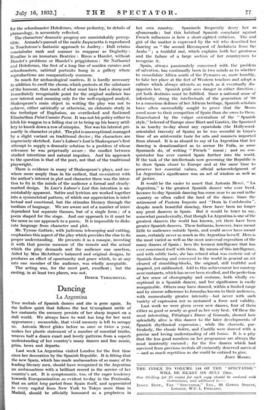Dancing
La Argentina
Two recitals of Spanish dances and she is gone again. In the hollow quiet that follows the last triumphant rattle of her castanets the memory persists of her sharp impact, on a dull world. We always have to wait too long for her next appearance ; meanwhile, that vivid memory is left to occupy us. Antonia Merce glides before us once or twice a year, makes her plastic statement of a number of essential truths, weaves half a dozen exact and lovely patterns from a superb understanding of her country's many dances and fine music, grins, bows and departs.
Last week La Argentina visited London for the first time since her decoration by the Spanish Republic. It is fitting that the new Spain, which has made ambassadors of so many of its leading literary men, should have recognized in the Argentina an ambassadress with a brilliant record in the service of her country's art. It is symptomatic, too, of the eager tendency towards Europeanization so evident to-day in the Peninsula, that an artist long parted from Spain itself, and appreciated in every capital from New York to Tokyo more than in Madrid, should be officially honoured as a prophetess in her own country. Spaniards frequently decry her as afrancesada ; but this habitual Spanish complaint against French influences is here a short-sighted criticism. The real gist of the matter is expressed by the wit who described her dancing as " the second Reconquest of Andalucia from the Arabs " ; a truthful mot, which explains both her greatness and the failure of a large section of her countrymen to recognize it.
Spain, always passionately concerned with the problem of salvation, has continually been in two minds as to whether to consolidate Africa south of the Pyrenees or, more humbly, to take her place at the feet of Western teachers and adopt a culture which always attracts as much as it eventually dis- appoints her. Spanish pride sees danger in either direction ; yet both destinies must be fulfilled. Since a national sense of inferiority stung the intellectuals of the generation of '98 to a conscious defence of her African heritage, Spanish scholars have often successfully sought to prove that the Moors owed more to their occupation of Spain than she owes to them. Exacerbated by the vulgar orientalism of the " Spanish style," beloved of Europe since Bizet and Gautier, the Spaniard is as touchy to-day about any espaaolada (the Hollywood- orientalist travesty of Spain) as he was scornful in Goya's time of an aristocratic taste for arts and manners imported from abroad. It is as absurd to say of La Argentina that her dancing is denationalized as to accuse De Falls, as some Spaniards do, of writing " French " music ; and no con- quistador has ever carried Spain further into the world. If the task of the intellectuals now governing the Republic is to draw Spain closer to Europe and at the same time to preserve her essential values, official acknowledgment of La Argentina's significance was an act of wisdom as well as of justice.
It would be the easier to assert that Antonia Merce, " La Argentina," is the greatest Spanish dancer who ever lived, because to-day Spanish dancing has come near to an end in the country so often called the land of the dance. Since the retirement of Pastore Imperio and Dora is Cordobesita ", despite much beautiful dancing, there have been no longer any great dancers in Spain. But it would be truer to say, somewhat paradoxically, that though La Argentina is one of the greatest dancers the world has known, yet there have been greater Spanish dancers. These bailaoras, however, have meant little to audiences outside Spain, and could never have meant more, certainly never as much as the Argentina herself. Hers is the most varied as well as the most universal exposition of the many dances of Spain ; hers the keenest intelligence that has ever concerned itself with them. By means of this intelligence, and with subtle taste, she has refined what was esoteric out of Spanish dancing and conveyed to the world in general an art cleared of stumbling-blocks, the original, still truthful and inspired, yet sublimated. Add to this achievement her mastery over castanets, which has never been rivalled, and the perfection of her sense of choregraphy and costume, both wholly ex- ceptional in a Spanish dancer, and her significance is easily recognizable. Others may have danced, within a limited range and by sincere adherence to formulas known to their audiences, with momentarily greater intensity—but never with such variety of expression nor so sustained a force and validity.
Last week we were given seven new dances, four of them either as good or nearly as good as her very best. Of these the most interesting, Pittaluga's Dance of Granada, showed how splendidly alive is this dancer to the later developments of Spanish rhythmical expression ; while the charrada, par- ticularly, the classic bolero, and Castilla were danced with a precise and loving understanding of old forms. It is a pity that the less good numbers on her programme are always the most insistently encored ; for the five dances which had survived from previous recitals all eminently deserved survival —and as much repetition as she could be enticed to give.
JOHN MARKS.


































 Previous page
Previous page